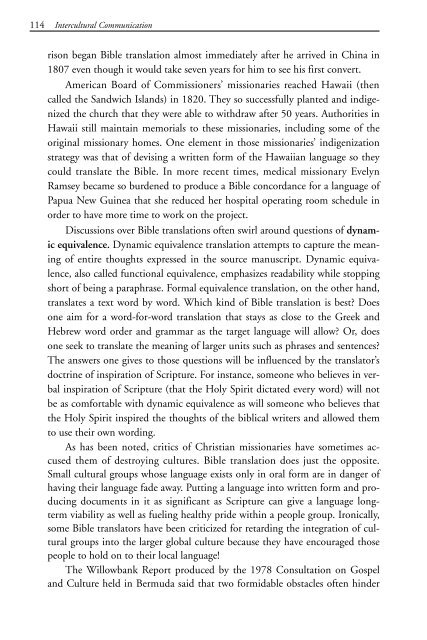discovering missions - Southern Nazarene University
discovering missions - Southern Nazarene University
discovering missions - Southern Nazarene University
Create successful ePaper yourself
Turn your PDF publications into a flip-book with our unique Google optimized e-Paper software.
245187 Disc Missions ins 9/6/07 1:04 PM Page 114<br />
114 Intercultural Communication<br />
rison began Bible translation almost immediately after he arrived in China in<br />
1807 even though it would take seven years for him to see his first convert.<br />
American Board of Commissioners’ missionaries reached Hawaii (then<br />
called the Sandwich Islands) in 1820. They so successfully planted and indigenized<br />
the church that they were able to withdraw after 50 years. Authorities in<br />
Hawaii still maintain memorials to these missionaries, including some of the<br />
original missionary homes. One element in those missionaries’ indigenization<br />
strategy was that of devising a written form of the Hawaiian language so they<br />
could translate the Bible. In more recent times, medical missionary Evelyn<br />
Ramsey became so burdened to produce a Bible concordance for a language of<br />
Papua New Guinea that she reduced her hospital operating room schedule in<br />
order to have more time to work on the project.<br />
Discussions over Bible translations often swirl around questions of dynamic<br />
equivalence. Dynamic equivalence translation attempts to capture the meaning<br />
of entire thoughts expressed in the source manuscript. Dynamic equivalence,<br />
also called functional equivalence, emphasizes readability while stopping<br />
short of being a paraphrase. Formal equivalence translation, on the other hand,<br />
translates a text word by word. Which kind of Bible translation is best? Does<br />
one aim for a word-for-word translation that stays as close to the Greek and<br />
Hebrew word order and grammar as the target language will allow? Or, does<br />
one seek to translate the meaning of larger units such as phrases and sentences?<br />
The answers one gives to those questions will be influenced by the translator’s<br />
doctrine of inspiration of Scripture. For instance, someone who believes in verbal<br />
inspiration of Scripture (that the Holy Spirit dictated every word) will not<br />
be as comfortable with dynamic equivalence as will someone who believes that<br />
the Holy Spirit inspired the thoughts of the biblical writers and allowed them<br />
to use their own wording.<br />
As has been noted, critics of Christian missionaries have sometimes accused<br />
them of destroying cultures. Bible translation does just the opposite.<br />
Small cultural groups whose language exists only in oral form are in danger of<br />
having their language fade away. Putting a language into written form and producing<br />
documents in it as significant as Scripture can give a language longterm<br />
viability as well as fueling healthy pride within a people group. Ironically,<br />
some Bible translators have been criticized for retarding the integration of cultural<br />
groups into the larger global culture because they have encouraged those<br />
people to hold on to their local language!<br />
The Willowbank Report produced by the 1978 Consultation on Gospel<br />
and Culture held in Bermuda said that two formidable obstacles often hinder

















